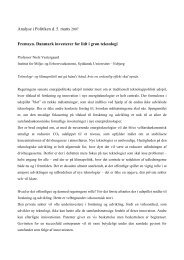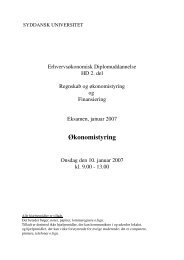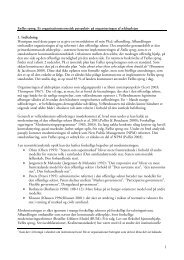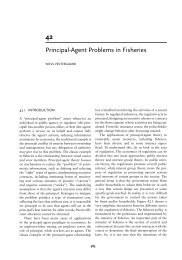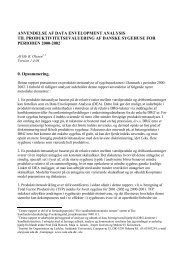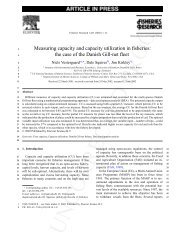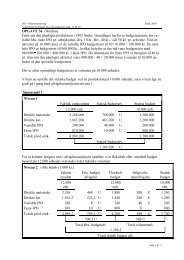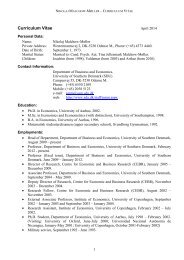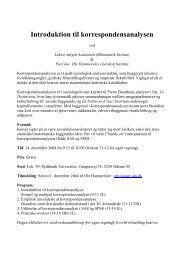After 1989 different types <strong>of</strong> political leaders emerged. Thus, the Hungarian Attila Ághdist<strong>in</strong>guishes between four groups:• “Politicians <strong>of</strong> morals”, who played a significant role <strong>in</strong> the first stage. They mostlyappealed to patriotic <strong>and</strong> national values.with references to their own “heroic past”. Aspoliticians they acted reserved, improvised, morally, non-pr<strong>of</strong>essionally <strong>and</strong> almostaristocratically, captured by a specific “liberation myth”. Pol<strong>and</strong>’s Jan Olszewski <strong>and</strong> theCzech Republic’s Vaclav Benda have been <strong>in</strong>cluded <strong>in</strong> that first group.• “Politicians <strong>of</strong> historical vision”. Politicians from that group <strong>of</strong>ten left the political sceneafter the demise <strong>of</strong> the old system. Before 1989 they had not been active dissidents. Aspoliticians they <strong>of</strong>ten based their arguments on idelogies <strong>and</strong> discourses go<strong>in</strong>g back to precommunisttimes. Before 1989, they had <strong>of</strong>ten entered compromises with the power holders.The political style was arrogant, not compromise seek<strong>in</strong>g <strong>and</strong> unpr<strong>of</strong>essional. Former primem<strong>in</strong>ister <strong>in</strong> Hungary Józef Antall <strong>and</strong> the christian democrat Jan carnogursky <strong>in</strong> Slovakiabelonged to that group. Also many politicians <strong>in</strong> the Baltic countries shared a feel<strong>in</strong>g <strong>of</strong>fullfill<strong>in</strong>g a historical mission reestablish<strong>in</strong>g <strong>in</strong>dependence after 50 years under communistrule. Nonetheless, many from that group had at some time been lead<strong>in</strong>g politicians under theold system., sometimes they explelled from the communist parties due to lack <strong>of</strong> partydiscipl<strong>in</strong>e.• “Politicians by chance”, i.e. persons who became “carried” <strong>in</strong>to politics because <strong>of</strong> the thenprevail<strong>in</strong>g extraord<strong>in</strong>ary politics <strong>and</strong> transition anomie. Several times people from that groupbecame embarassment for further consolidation <strong>of</strong> democracy due to their agressive selfpromot<strong>in</strong>gstyle <strong>and</strong> onesided aim<strong>in</strong>g at political career. Several from that group were<strong>in</strong>volved <strong>in</strong> political sc<strong>and</strong>als, <strong>and</strong> many absurd, <strong>of</strong>ten populist <strong>and</strong> xen<strong>of</strong>obic policalslogans. Stanislaw Tym<strong>in</strong>ski, Lech Walesa’s rival c<strong>and</strong>idate at the 1990 presidentialelection, Miroslav Sladek, the leader <strong>of</strong> the right w<strong>in</strong>g populistic repubican party <strong>in</strong> theCzech Republic, Istvan Czurka, the r<strong>in</strong>ght w<strong>in</strong>g nationalist <strong>in</strong> Hungary, <strong>and</strong> VladimirZjir<strong>in</strong>ovski, the leader <strong>of</strong> the populist Liberal Democratic <strong>Party</strong> <strong>in</strong> Russia, belonged to thatgroup.• The old nomenklatura, which to a great extent has survived. Especially the modern part <strong>of</strong>the nomenklatura made a good show<strong>in</strong>g. The conservative “beton-heads” either resignedfrom politics or turned themselves <strong>in</strong>to nationalists. Pol<strong>and</strong>’s president e <strong>and</strong> former leader<strong>of</strong> the left w<strong>in</strong>g SLD Aleks<strong>and</strong>er Kwasniewski <strong>and</strong> Hungary’s former foreign m<strong>in</strong>ister,prime m<strong>in</strong>ister Guyla Horn belonged to the “modern” <strong>and</strong> accomodate part <strong>of</strong> thenomaneklatura.• F<strong>in</strong>ally Attila Ágh mentiones the new pr<strong>of</strong>essionals, a mixture <strong>of</strong> old <strong>and</strong> new, mostlyconsist<strong>in</strong>g <strong>of</strong> experts <strong>and</strong> pr<strong>of</strong>essionals from the old regime or yungsters without any l<strong>in</strong>ksback <strong>in</strong> time. To the first generation <strong>of</strong> pr<strong>of</strong>essionals, people from the “second tier” <strong>of</strong> theold system, belonged Vaclav Klaus, the party leader <strong>of</strong> the liberal party ODS <strong>and</strong> later thepresident <strong>of</strong> the Czech Republic, <strong>and</strong> Leszek Balcerowicz, the former M<strong>in</strong>ister <strong>of</strong> F<strong>in</strong>ance,leader <strong>of</strong> the liberal Freedom Union (UW), later the Polsh national bank governor.In agreement with Atilla Ágh, András Bozóki from the Central European University <strong>in</strong> Budapest,breaks down <strong>of</strong> the new elite <strong>in</strong> this way:32
• To the first group belong the pr<strong>of</strong>essionals, who so to say were “born” <strong>in</strong>to politics, whorecognised that, were <strong>in</strong> possession <strong>of</strong> a good ability to adapt themselves to new situations<strong>and</strong> f<strong>in</strong>d their bear<strong>in</strong>gs <strong>in</strong> new unpredictable situations. Many reformm<strong>in</strong>ded communistsbelonged tho that group.• The next group was the those do<strong>in</strong>g “missionary work”, i.e. persons, who felt to perform ahistorical mission. Often we were deal<strong>in</strong>g with writers <strong>and</strong> other cultural personalities,almost “carried” <strong>in</strong>to politics. For those people politics was not a goal <strong>in</strong> itself, the goalswere rather metapolitical.• To the third group belonged the “divided”, i.e. people who were not power orientated <strong>and</strong>with an unclear vision about heir own role <strong>in</strong> politics <strong>and</strong> the political future. Many fromthat resigned from politics with the pr<strong>of</strong>essionalisation or bureaucratisation <strong>of</strong> politics.• F<strong>in</strong>ally there were people who soon after the break through <strong>in</strong> 1989 resigned from politics,some returned to their former work, others moved to the new private sector <strong>and</strong> becamepolitical advisors.Furthermore, it is important, how many ressources <strong>and</strong> how great a “capital” that belongs to the thedifferent elite groups (Szelelyi e.a., 1995). Accord<strong>in</strong>g to “capital” we can differentiate between fourdifferent types:• Economic capital, i.e. the possession <strong>of</strong> property <strong>and</strong> ccess to f<strong>in</strong>anciation, state subsidiesetc.• Cultural capital, e.g. education.• Societal capital, e.g. close networks horsontally <strong>and</strong> vertically.• The ability to convert capital by us<strong>in</strong>g the already established networks to exchangepolitical by economic capital.In some studies a dist<strong>in</strong>ction has been made between “laissez faire”, “transactional <strong>and</strong>“transformational” political leadership (Heywood, 1998:334). In the case <strong>of</strong> laissez-faire leadershipwe have to do with a considerable delegation <strong>of</strong> political power to lower levels <strong>of</strong> decision mak<strong>in</strong>g;<strong>in</strong> case <strong>of</strong> transactional leadership were are deal<strong>in</strong>g with a “h<strong>and</strong>s-on” leadership emphasiz<strong>in</strong>gpragmatic goals <strong>and</strong> underl<strong>in</strong><strong>in</strong>g party unity <strong>and</strong> party cohesion; <strong>and</strong> <strong>in</strong> case <strong>of</strong> transformativeleadership ma<strong>in</strong> emphasis has been laid on visions, <strong>in</strong>spiration <strong>and</strong> carismatic leadership. In case <strong>of</strong>transformative leadership the weight has been laid on the closest as possible contact between elites<strong>and</strong> voters by means <strong>of</strong> political mobilisation with the aim to carry through the most necessaryreforms <strong>of</strong> society.As noted above, the parties were established top-down <strong>and</strong> for that reason they also to a great extentbecame elite governed. In most cases the new elites were <strong>in</strong> short <strong>of</strong> strategic visions <strong>and</strong><strong>in</strong>stitutional capacity to translate visions <strong>and</strong> strategies <strong>in</strong>to action. In the first stage <strong>of</strong> postcommunismthe leadership <strong>in</strong> most cases was “h<strong>and</strong> on” as the new elites had to formulate a new33
- Page 3: “This provisional situation chara
- Page 6 and 7: marketisation and privatisationshor
- Page 8 and 9: purposes, are channels for “expre
- Page 10 and 11: the significance of strategic choic
- Page 12 and 13: presidentialism gave rise to “flo
- Page 14 and 15: antipolitics and reinforcement of a
- Page 16 and 17: In the late 1990’s elections most
- Page 18 and 19: determined primarily by “politica
- Page 20 and 21: politics and antipolitics, all sign
- Page 22 and 23: which attitudes to state regulation
- Page 24 and 25: Anti-communism has been defined in
- Page 26 and 27: elections and the Slovak communists
- Page 28 and 29: Cartel agreementsbetter representat
- Page 30 and 31: Basically the absence of clear cons
- Page 34 and 35: complex project for transition unde
- Page 36 and 37: window of opportunity in spite of s
- Page 38 and 39: analyses of party institutionalizat
- Page 40 and 41: political messages and slogans. Thu
- Page 42 and 43: well established party culture may
- Page 44 and 45: expected, much due to the many spli
- Page 46 and 47: Furthermore, the polarisation on el
- Page 48 and 49: Finally, Solidarity can also be con
- Page 50 and 51: whole, on the one side an authorita
- Page 52 and 53: The economic recession and the grav
- Page 54 and 55: election defeat more cooperation an
- Page 56 and 57: The formation of AWS can be conside
- Page 58 and 59: group. RS AWS constituted the Chris
- Page 60 and 61: According to the original plans the
- Page 62 and 63: values. According to Rybicki, as so
- Page 64 and 65: AWS should fight against all types
- Page 66 and 67: 2001 parliamentary election, howeve
- Page 68 and 69: and workers voted ZChN. At the 1993
- Page 70 and 71: The League has been considered as a
- Page 72 and 73: establishment like than LPR’s. Th
- Page 74 and 75: jobs in rural areas, especially sma
- Page 76 and 77: industrial policy. According to the
- Page 78 and 79: pressurizing the government to give
- Page 80 and 81: democrats, thereby locating itself
- Page 82 and 83:
To conclude, the Freedom Union (UW)
- Page 84 and 85:
Polish middle class. Thus, in Janua
- Page 86 and 87:
such as KSCM and KSS in The Czech R
- Page 88 and 89:
The SLD leaders were mainly recruit
- Page 90 and 91:
the falling popular support for pri
- Page 92 and 93:
innovation was formation of the pol
- Page 94 and 95:
place after talks with each applica
- Page 96 and 97:
Has the Left any freedom of manoeuv
- Page 98 and 99:
medicine, changes in the labour cod
- Page 100 and 101:
The Labour Union (UP), Democratic U
- Page 102:
Nevertheless, before that had taken



